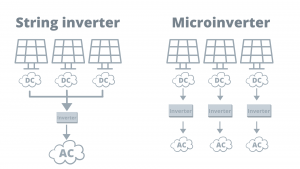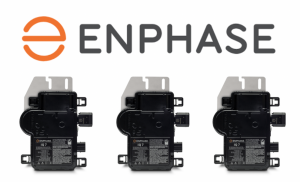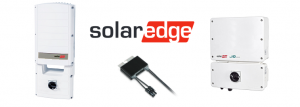We sell two main inverters: Enphase and SolarEdge. Below is some information about each of them – feel free to contact us with any questions!
Definitions
Before we dive into all the inverter details, here is a little refresher on how solar panels work. To generate electricity, sunlight shines on a panel and this panel converts the solar energy into DC current. This current flows to the inverter where the it converts DC current to AC current. Your home uses this AC current to power things like air conditioning, heat, etc. For a more detailed explanation on how solar works, click here.

Below are a few useful definitions. For more information, click here.
String inverters: String inverters are centralized inverters. They take DC current from multiple panels and convert it to AC current. These panels are connected by a string which sends the DC current to the inverter, where it converts DC to AC current. String inverters are standard and reliable solar technology, and are the most commonly used type of inverter. They are also the least expensive inverter option.
Microinverter: Microinverters convert DC to AC current at each individual solar module. They are located behind each panel and therefore offer individual panel monitoring, meaning that you can track how many kilowatt-hours each individual panel in the system produces. Microinverters are especially effective for roofs that experience shading and other conditions that affect the output of some of the panels. Since microinverters are mounted behind each individual panel, if half of a roof is covered by shade, the other half of the roof will still produce at full capacity. This increases efficiency and is an advantage over string inverters. However, microinverters are more expensive and have a higher upfront cost.
Power Optimizers: Power optimizers are a middle ground between string and microinverters. They are similar to microinverters because they are placed behind each individual solar panel and allow monitoring of individual panels. They are also a good option for roofs that experience shading. However, they are DC to DC converters, meaning they condition DC current then send it to a centralized inverter which converts DC to AC current. By conditioning the DC current, they allow the current to be more efficiently converted to AC at the central inverter and increases overall inverter efficiency.
Single phase vs. three phase inverters: The main differences between single and three phase inverters are their size and consistency. Three phase inverters are often used for larger systems, and provide more consistent energy flow. Single phase inverters are used for smaller loads and provide a less consistent energy flow.
Enphase
Enphase Energy manufacturers microinverters. The company has been a key part of the solar industry throughout the last decade. They released the first microinverter in 2008 and have since seen a lot of success in North America. They also offer a 25-year warranty on their product.
Because Enphase makes microinverters, each panel has its own inverter. This means that if half of the panels are in the shade, the ones in the sun will still operate at full capacity. (With string inverters, the whole system only operates as well as the least functional panel. This means that if shade covers half the panels and reduces their output, the rest of the panels will also operate at a reduced capacity).
Enphase inverters are NEMA 6 certified, meaning that they are certified to be able to handle harsh and inclement weather. They are tested in high temperatures in Australia, so they will certainly be able to handle any heat New England throws at us! Enphase inverters are also equipped to handle situations that might caused reduced output such as shading, soiling, individual panel damage or degradation, and unideal roof layout.
Additionally, because of the customizable microchip in their inverter, Enphase make it easy to expand a solar panel system and add more wattage. However, because of the technology that comes with the increased efficiency of microinverter, Enphase inverters are more expensive.
SolarEdge
SolarEdge offers a string inverter + power optimizer system. This system gives some of benefits of microinverters to string inverters. For example, SolarEdge inverters are capable of system monitoring at each panel. Additionally, shade on one or two panels does not affect the output of the whole system. SolarEdge inverters also include a safety feature that allows them to be shutdown down quickly in an emergency situation.
SolarEdge has single phase and three phase inverters. The single phase range from 2.2 kW to 6 kW, and are mostly for residential use. The three phase range from 4 kW to 33.3 kW and are often for commercial and industrial sites.
SolarEdge inverters are small and lightweight. Since string inverters tend to be cheaper and simpler than microinverters, with SolarEdge you can get lower costs than you would buying an microinverter. The power optimizers on a SolarEdge system allow you to easily expand a solar panel system and add more panels if necessary. SolarEdge also offers a 12 year warranty on their product.
Contact us
There is a lot to think about when considering which inverter is best for you. Feel free to reach out and contact us with any questions, and to get a free solar quote so we can tell you what we think will suite your solar needs.
Datasheets
The following datasheets give more detailed information from each company about their inverters.


